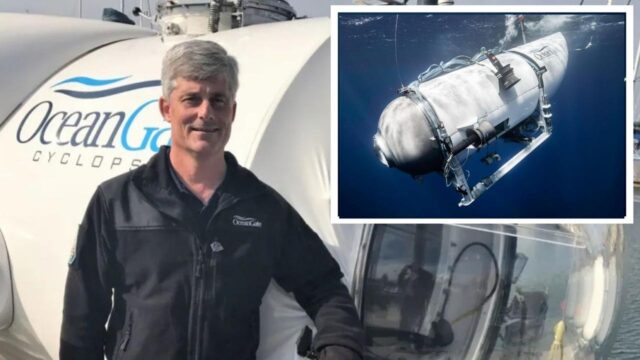The Depths of Humanity

Netflix’s documentary on the OceanGate submarine disaster offers a soul-searching meditation on ambition and greed.
Directed by Mark Monroe ◆ Produced by Mark Monroe, Lily Garrison, and Jon Bardin ◆ Distributed by Netflix
“Invulnerable” was how the late OceanGate Explorations CEO Richard Stockton Rush III—or just “Stockton” to his few friends and many detractors—described his small developing fleet of submersible vessels in a video presentation to the vaunted Explorers Club in 2017 (full disclosure: I am a member of the Explorers Club but never encountered Rush in person or saw his video prior to writing this review). Mark Monroe, a former CNN television newswriter who has built a modest career in documentary film production, does not draw the obvious comparison in his 2025 Netflix documentary Titan: The OceanGate Disaster. But in retrospect, and from beyond his watery grave, Rush’s confidence sounds mightily like the hubris surrounding the RMS Titanic, briefly the world’s fastest and most luxurious ocean liner, which was hailed as “unsinkable” before it plummeted to the ocean floor with great loss of life on its maiden voyage in 1912.
The comparison is beyond apposite. In June 2023, 111 years after the Titanic sank, Rush’s venture turned out to be fatal for him, the accompanying French marine explorer and Titanic expert Paul-Henri Nargeolet, and three commercial passengers, when one of his deep-sea submersibles, the Titan, imploded under high pressure. The accident occurred more than two miles beneath the surface of the North Atlantic and just 1,600 feet from the wreckage of the Titanic’s bow.
The eerie similarities don’t end there. While Monroe’s film curiously never explores the economics of Rush’s deep-sea tourism, the entrepreneur initially set his per-passenger price to equal the inflation-adjusted price of a first-class ticket for the Titanic’s maiden voyage, according to a 2019 Smithsonian magazine article. That figure initially came out to $105,129, but Rush later increased it to $125,000 and then doubled that number to $250,000 by the time of his demise.
That people would still be captivated by the Titanic more than a century after its tragic sinking was but one assumption Rush appears to have made up to the time of his death, which followed his life’s quest to revolutionize ocean exploration. As his past business associates and employees testify with almost monotonous repetition in Monroe’s film, his overpowering ambition was to equal Jeff Bezos and Elon Musk as a “visionary” who would do for the world’s oceans what those notable entrepreneurs have begun to do for outer space.
Why Rush thought the ocean would help him rise to that level is not really explained. Did he expect, like Jules Verne’s misanthropic Captain Nemo, to find an escape from humanity and vast treasures deep beneath the surface of the sea? Did he believe the ocean floor would prove irresistible to a community large enough to devote time, resources, and lethal risk to its exploration? What could his enterprise have accomplished that the U.S. Navy— whose nuclear-powered submarines can patrol for months without surfacing while carrying enough atomic firepower to devastate the earth—has failed to achieve? Obviously, he was not around to testify, but Monroe disappointingly never uncovers his reasoning.
The filmmaker does have a great deal to say, however, about Rush’s ambition. Descended from two signers of the Declaration of Independence, Richard Stockton and Benjamin Rush, he grew up in what Monroe characterizes as an atmosphere of privilege and entitlement combined with a Boomer-generation interest in science fiction and outer space. He glosses over Rush’s education, which included a Princeton degree in aerospace engineering—a demanding STEM major no matter who your ancestors were—and an apparently distinguished career as an F-15 fighter jet test pilot for McDonnell Douglas. After those early feats, he went into venture capital, where he channeled his wealth to grow his recreational interest in scuba diving into a more sophisticated means of underwater exploration. He and a partner founded OceanGate in 2009, but the company took a long, winding, and often frustrating road before it began offering commercial underwater tourism trips to the wreck of the Titanic. These only started in 2021 and were bedeviled by operational challenges that limited the number of “missions” he could carry out.
In the process, according to Monroe’s telling, Rush quite literally succumbed to his ambitions. As witness after witness verifies, he cut corners, underestimated pitfalls, ignored warnings about defects and other safety concerns, removed or ostracized people who ceased to share his optimism, accused apparently honest critics of ill will or fraud, and generally behaved with a towering arrogance and malignant narcissism that made his fatal product—the Titan submersible—not merely prone to accident but doomed to inevitable destruction.
One damning public statement after another by Rush himself appears to confirm that he dismissed safety concerns as “understandable but illogical” and ignored federal regulations, especially the Passenger Vessel Safety Act of 1993, as something that “needlessly prioritized passenger safety over commercial innovation,” according to Smithsonian magazine’s account.
“At some point, safety just is pure waste,” Rush had told CBS News science and technology reporter David Pogue, who participated in one of Rush’s Titanic dives as part of a news story. “I mean, if you just want to be safe, don’t get out of bed, don’t get in your car, don’t do anything. At some point, you’re going to take some risk, and it really is a risk/reward question. I think I can do this just as safely by breaking the rules.”
Because of Rush’s reckless attitude, it is hard to reach any other conclusion than that the disaster, which claimed his life and those of his four fellow passengers, was entirely his fault.
Lest anyone suspect differently, the film points out that Rush deliberately operated his company in international waters to avoid national maritime regulations and chartered and launched his main supporting vessel from a Canadian port to escape U.S. rules and oversight. According to the separate accounts of two friends of mine who completed the Titanic dive successfully and mercifully survived, they were compelled to sign liability waivers that identified the trip as “experimental” and included the word “death” three times on the first page. Monroe’s film produces a brief screenshot of the waiver my friends described, but he does not seem to have learned much about the experience by interviewing them or other survivors.
Apart from Nargeolet, whose daughter was interviewed about her father’s attitude toward the project and expedition, the film is also sparse in its treatment of the victims who perished alongside Rush. The identities of the three tourists, Hamish Harding and Shahzada and Suleman Dawood, were well-known to the media. The human dimension their stories would have added to the film was lost, but a few facts bear retelling here. Harding, a Dubai-based British executive in the IT, investment, and aircraft brokerage industries, was an accomplished pilot and Antarctic explorer who had previously descended in a sounder submersible to the floor of the Mariana Trench, the deepest point on earth. Like Nargeolet, he was a fellow member of the Explorers Club, which immediately got to work in supporting and helping to coordinate the rescue efforts, and was serving on the club’s board of trustees at the time of his death. Shahzada Dawood was an heir to the Pakistani business conglomerate of his family name. A noted philanthropist with a lifelong interest in the Titanic, he was accompanied by his 19-year-old son Suleman after his wife decided not to go and gave him her ticket.
Monroe considerably simplifies the science of Titan’s destruction. We learn disappointingly little about how submarines work, what scientific factors figure in the development and operation of deep-diving submersibles, exactly how or when Rush went wrong in his calculations and intent, or really much beyond the widely attested hypothesis that using carbon fiber in the hull construction was unsafe, that Rush knew it, and that he proceeded with his project for years anyway.
If the film offers little to explain the science, it does a frighteningly effective job of showing the warning signs. An audio system to record sounds indicating hull stress delivers a harrowing soundtrack of cracking noises that would, if fully disclosed, likely have led any sensible person to decline to participate in such an expedition. The implosion that eventually destroyed Titan registered as a distant rumble that sounds eerie, knowing what happened after the fact, but was initially thought to be inconclusive. Nevertheless, for four days the world was captivated by the idea that the submersible, which was believed to be merely out of contact, might have survived and that the passengers might have enough oxygen to be rescued. The connection to the Titanic wreck and sheer scale of the technical disaster, perhaps along with good old-fashioned sensationalism, were enough to drive from the headlines the near-simultaneous sinking of the overloaded Greek ferry Adriana, which cost more than 500 lives.
If the film has a hero, it is OceanGate’s former operations director, David Lochridge, who Rush fired in 2018 due to their disagreements over safety. Lochridge subsequently filed a complaint against his former employer with the Occupational Safety and Health Administration (OSHA). OceanGate responded by suing Lochridge and his wife for violating a nondisclosure agreement. Lochridge countersued but says he was eventually forced to settle out of court and to withdraw his OSHA complaint due to mounting legal bills.
If Rush had listened to Lochridge, he might well be alive today, safely bringing well-off tourists to ponder the mysteries of another human folly, instead of being crushed to death in the ocean deep.
https://chroniclesmagazine.org/reviews/the-depths-of-humanity
